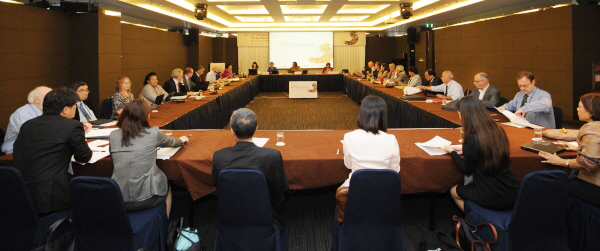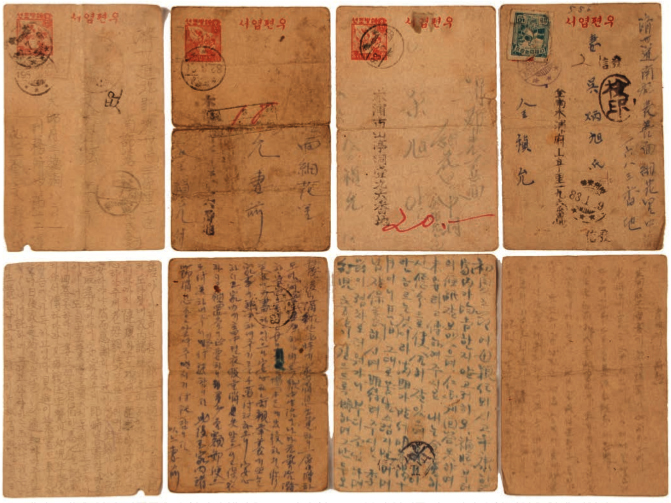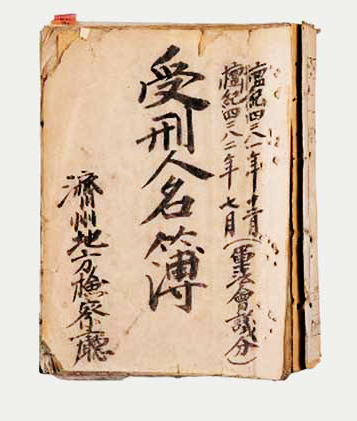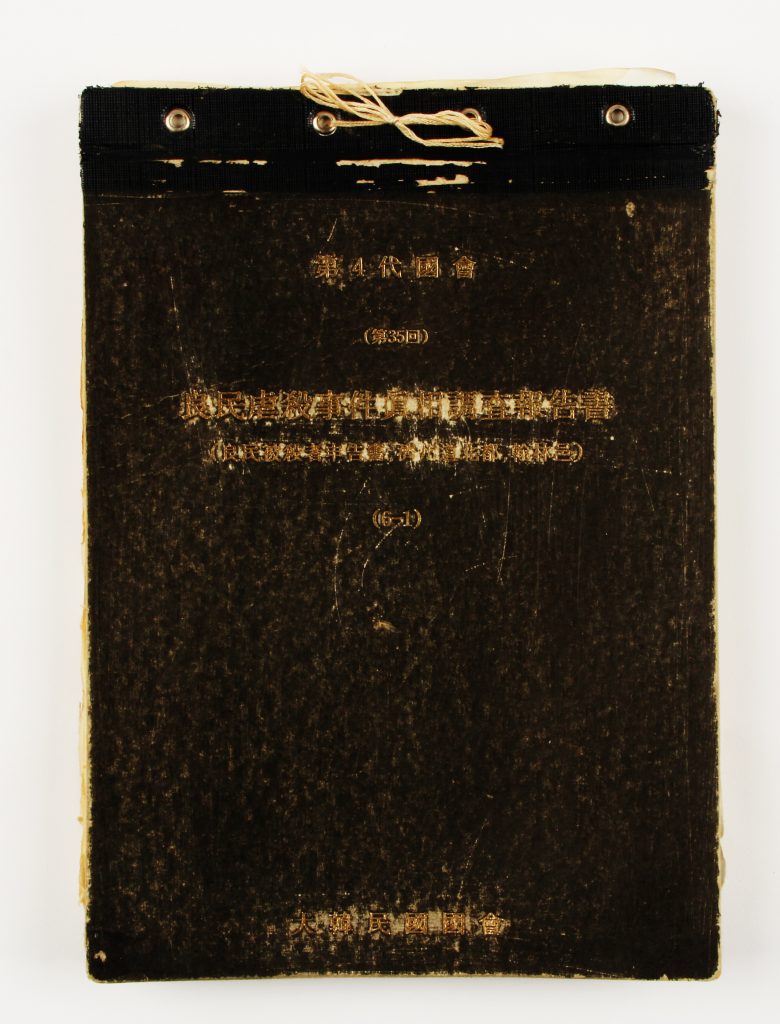Efforts to Have Jeju 4·3 Recognized as a Memory of the World
– Current Status and Challenges of Inscribing the Archives of Jeju 4·3 on UNESCO’s Memory of the World Register –
Park Chan-shik Senior Researcher, Project for Inclusion of the Archives of Jeju 4·3 in Memory of the World Register, Jeju 4·3 Peace Foundation

Gwangju hosted the 11th meeting of the International Advisory Committee of UNESCO’s Memory of the World Programme in 2013. The IAC reviewed 84 nominations from more than 50 countries for inclusion in UNESCO’s Memory of the World Register. The Republic of Korea’s nominations included the Archives of Nanjung Ilgi: War Diary of Admiral Yi Sun-sin and the Archives of Saemaeul Undong (New Community Movement)
Overview of UNESCO’s Memory of the World Programme
UNESCO established the Memory of the World (MoW) Programme in 1992. The impetus came from a growing awareness of the parlous state of preservation of, and access to, documentary heritage in various parts of the world. Because the world’s documentary heritage belongs to everyone, the mission of the MoW Programme is to facilitate preservation and protection of documentary heritage for future generations, to assist universal access to the heritage, and to increase awareness worldwide of its existence and significance.
The International Advisory Committee (IAC), the peak body responsible for advising UNESCO on the planning and implementation of the MoW Programme, met for the first time in 1993 to set the frame of the programme and create an action plan. The programme has inscribed the world’s documentary heritage on the MoW Register since the Memory of the World: Register General Guidelines to Safeguard Documentary Heritage was adopted at the 1995 UNESCO General Assembly.
All kinds of documentary heritage, corresponding to the selection criteria regarding world significance and outstanding universal value, are listed on the MoW Register following an IAC review, while technical support is provided for the preservation of, and access to, documentary heritage. With the selection criteria revised in 2002, the register now covers a broad range of media and means, not just literary documentation but also digitized resources such as visual documents, virtual documents, etc.
The inclusion of documentary heritage on the MoW Register is determined through a review by the IAC in its biennial ordinary session, when each member state is able to put forward up to two new nominations. In the Republic of Korea, the Cultural Heritage Administration submitted to the IAC ordinary session the application for two candidates selected through a preliminary application and review. To be inscribed on the MoW Register, the nomination should be important to the world. The IAC comprehensively assesses the documentary heritage against the criteria of integrity, authenticity (irreplaceability), significance, rarity, management plan, etc.
So far, 427 nominations by 128 countries and eight organizations have been added to the MoW Register. The representative nominations that have been inscripted include the Netherlands’ Archives of the Dutch East India Company and the Diaries of Anne Frank, the United Kingdom’s Registry of Slaves of the British Carribean 1817-1834, Egypt’s Memory of the Suez Canal, Denmark’s Manuscripts and correspondence of Hans Christian Andersen, Colombia’s Negros y Esclavos Archives, and Germany’s 42-line Gutenberg Bible, printed on vellum, and its contemporary documentary background.
Currently, the following 16 items applied by the Republic of Korea have been inscribed on the MoW Register:
|
Year of Inscription |
Name of Documentary Heritage |
| 1997 |
⋅The Hunmin Chongum Manuscript ⋅The Annals of the Choson Dynasty |
|
2001 |
⋅Baegun hawasang chorok buljo jikji simche yojeol (vol. Ⅱ), the second volume of “Anthology of Great Buddhist Priests’ Zen Teachings” ⋅Seungjeongwon Ilgi, the Diaries of the Royal Secretariat |
|
2007 |
⋅Printing woodblocks of the Tripitaka Koreana and miscellaneous Buddhist scriptures ⋅Uigwe: The Royal Protocols of the Joseon Dynasty |
|
2009 |
⋅Donguibogam: Principles and Practice of Eastern Medicine |
|
2011 |
⋅Ilseongnok: Records of Daily Reflections ⋅Human Rights Documentary Heritage 1980 Archives for the May 18th Democratic Uprising against Military Regime, in Gwangju, Republic of Korea |
|
2013 |
⋅Nanjung Ilgi: War Diary of Admiral Yi Sun-sin ⋅Archives of Saemaul Undong (New Community Movement) |
| 2015 |
⋅The Archives of the KBS Special Live Broadcast “Finding Dispersed Families” ⋅Confucian Printing Woodblocks |
| 2017 |
⋅Royal Seal and Investiture Book Collection of the Joseon Dynasty ⋅Archives of the National Debt Redemption Movement ⋅Documents on Joseon Tongsinsa/Chosen Tsushinshi: The History of Peace Building and Cultural Exchanges between Korea and Japan from the 17th to 19th Century |
Value of the Archives of Jeju 4·3 as a Documentary Heritage under the MoW Criteria
The Archives of Jeju 4·3 refers to all pertinent resources, including, but not limited to, the text items, audiovisual items such as photographs and films, and artifacts associated with the people involved in the incident that have been documented and/or produced concerning the massacre of tens of thousands of residents during the armed clashes between the civilian armed guerillas and the counterinsurgency forces, which took place on Jeju Island, the Republic of Korea, from March 1, 1947, to Sept. 24, 1954, as well as the subsequent process of clarifying the truth related to the incident and restoring honor to the victims.
The Archives of Jeju 4·3 is largely divided into the documentary heritage items produced at the time of the incident and those produced afterward.
The documentary heritage items produced at the time contain the “truth of the Cold War, national division, and massacres.” The representative materials include government documents (e.g. Cabinet Meeting minutes, etc.), documents produced by the constabulary forces or the armed guerillas, administrative/criminal records (e.g. written judgments, List of Convicts, etc.), materials owned by other countries (e.g. the United States, Russia, Japan, etc.), photographs, films, and artifacts associated with the people involved in the incident.
The documentary heritage produced afterward is related to justice, peace and human rights, and reconciliation and mutual existence. The heritage items in this category are represented by the register of victims who have been reported (1,878 victims estimated by the National Assembly, 14,343 victims estimated by the Jeju Special Self-Governing Provincial Council, and 14,532 victims estimated by the Committee on Discovering Truth on Jeju 4·3 Incident and Restoration of Honor of Victims or Jeju 4·3 Committee), materials of different groups involved in the movement for clarification of the truth of Jeju 4·3, findings of the investigation by the Jeju 4·3 Committee (e.g. The Jeju 4·3 Incident Investigation Report, documents concerning the confirmation of victims, white papers, etc.), oral testimonies by victims and their families, resources related to the exhumation of remains from secret burial sites, materials produced for the purpose of social cohesion (e.g. collective memorial services, etc.), documents detailing international exchanges and cooperation concerning Jeju 4·3, and civilian resources (e.g. personal journals, memoires, essays, press coverages, etc.).
The Archives of Jeju 4·3 has an outstanding universal value in that it accounts for how people have overcome the tragic massacre of Jeju Island residents by state violence, which occurred amid the international and domestic situation of the Cold War and the division of the Korea Peninsula, and have achieved reconciliation, peace, and mutual existence between the victimized and the perpetrators. As an exemplary case of resolving unsettled past affairs, the documentary heritage suggested the “future-oriented vision for truth, reconciliation, mutual existence, and peace,” which surpassed South Africa’s “truth and reconciliation process.” The Archives of Jeju 4·3 is also affluent in type and content, compared with other civilian massacres by state power, while well-preserving the records of more than 15,000 victims. This is why many scholars and journalists around the world have paid attention to the resolution process of Jeju 4·3.
Promotion of Including the Archives of Jeju 4·3 on UNESCO’s MoW Register
The owners of the Archives of Jeju 4·3 vary, ranging from public institutions to private individuals. Currently, the documentary heritage items are dispersedly held by the Jeju 4·3 Peace Foundation, domestic and international archive institutions, private research institutes, and other Jeju 4·3-related groups such as the Association for the Bereaved Families of Jeju 4·3 Victims, as well as private individuals.
The documentary heritage items related to Jeju 4·3 began to be collected while the Jeju 4·3 Committee was developing the Jeju 4·3 Incident Investigation Report from 2000 to 2003. The key items collected and arranged by the committee were published as the source book of 12 volumes. The heritage items have been more systematically collected and arranged since 2008 when the Jeju 4·3 Historical Archives (renamed to the Jeju 4·3 Peace Memorial Hall) opened and the Jeju 4·3 Peace Foundation was established. Currently, the Archives of Jeju 4·3 is held in the Storage and the Archives Room of the Jeju 4·3 Peace Memorial Hall. The Jeju 4·3 Peace Foundation launched the online archives (http://43archives.or.kr) in 2017 and has since allowed people to access information on more than 12,000 items related to the Archives of Jeju 4·3.
Meanwhile, the Jeju 4·3 Peace Foundation witnessed the MoW inscription of Human Rights Documentary Heritage 1980 Archives for the May 18th Democratic Uprising against Military Regime, in Gwangju, Republic of Korea. This provided the foundation with the impetus to consider the inclusion of the documentary heritage items related to Jeju 4·3 because Jeju 4·3 and the May 18 Democratization Movement are similar in contemporary Korean history. In December 2012, the Jeju 4·3 Peace Foundation hosted an experts debate to open the discussion on the MoW inscription of documentary heritage related to Jeju 4·3. Subsequently, the administrative authorities of the Jeju Special Self-Governing Province took the lead by designing the related project through opinion gathering, and in 2018, undertook the promotional project of including the Archives of Jeju 4·3 on the MoW Register.
In 2019, the Jeju 4·3 Peace Foundation signed a memorandum of understanding with the local government to actively promote the MoW inscription project. First, the foundation sorted the necessary documentary heritage items, mainly from among those being held by the Jeju 4·3 Peace Memorial Hall, while developing a list of all the items while building a database. The foundation also secured references for preparing the nomination by publishing the Korean translations of nomination forms submitted concerning domestic and international cases that are similar to Jeju 4·3. In December 2019, the foundation organized an international symposium by inviting world-prominent experts on MoW such as Jan Bos (chair of the Register Sub-Committee for the International Register, International Advisory Committee of UNESCO Memory of the World Programme). During the conference, the foundation shared with the participants the process and outcomes of promoting the MoW inscription of the Archives of Jeju 4·3, while briefing them on the purpose of the MoW inscription project.
In 2020, the foundation began preparing the application, based on the performance outcomes of the past few years. The ongoing activities include the development of a first draft of the nomination form and the classification and arrangement of the applicable items by type, time of production, and keywords. The campaign for collecting individually owned documentary heritage is also underway, alongside the audiovisual documentation of oral testimonies through video interviews with key figures of the movement for the clarification of the truth of Jeju 4·3. Late in December, the foundation will hold an exhibition on the Archives of Jeju 4·3 to open to the public the documentary heritage collected for MoW inscription.
Future Prospects and Challenges
The International MoW Programme is currently suspended due to the discussion on enhancing the practices in memory institutions. China’s Documents of Nanjing Massacre was added to the MoW Register in 2015. In 2017 when civic groups in Korea, China, and Japan submitted Documentation on “Comfort Women” and Japanese Army Discipline as a new nomination, the Japanese government demanded a reform of the practices in memory institutions, claiming that the UNESCO Programme is being used for political purposes. Japan even suspended its financial contribution to UNESCO in protest. In 2018, UNESCO started the discussion on the institutional enhancement of its MoW Programme by forming a related Working Group.

Postcards that Jeju 4·3 convicts sent home from prison

List of Convicts written by courts-martial during Jeju 4·3

Civilian Massacre Investigation Report published by the 4th National Assembly in 1960
The institutional improvement, which had been slated to be completed by the end of 2019, continued throughout 2020 when the deadline was suspended again due to the COVID-19 pandemic. The draft of the institutional enhancement will be confirmed as early as March 2021. Should the draft be approved by the UNESCO Executive Board as planned, the application process will likely resume in the latter half of 2021. When the MoW nomination process resumes, the Republic of Korea will submit its nomination forms for the documentary heritage items on the Donghak Peasant Revolution and the April 19 Pro-Democracy Movement. If submissions are permitted every two years in accordance with the original nomination cycle, the next nomination period will be in 2023, for which South Korea’s candidates will be reviewed domestically in 2022.
The local government and the Jeju 4·3 Peace Foundation consider the suspension of the International MoW Programme as an opportunity to focus on improving the quality of management of the Archives of Jeju 4·3. The system concerning the collection, management, and online/offline opening of the documentary heritage is planned to be fundamentally reorganized. The government and the institution are designing a project to enhance the online archives system to be offered on an advanced platform with easier access to the abundance of data. Additionally, the tentatively named Jeju 4·3 Archives Memorial Hall, which will be established in the near future, will be test operated through the exhibition on the Archives of Jeju 4·3 in December 2020.
Priority will be given to preparing the nomination application for the national audition, which will happen in two years. Attention will also continue to be paid to exchanges with related institutions in Korea and overseas. The potential MoW inscription of the Archives of Jeju 4·3 will help share the universal value of Jeju 4·3 with the world and give the Republic of Korea an opportunity to be globally recognized as a country with a mature sense of human rights. The successful inscription will also help the nation overcome the history of the Cold War, national division, a series of dictatorships, segmentation, and confrontation. The official global recognition that Jeju 4·3 pursued the values of truth, peace and human rights, and reconciliation and mutual existence is expected to eventually help resolve the ideological conflicts as well as globalize the case example of Jeju 4·3.